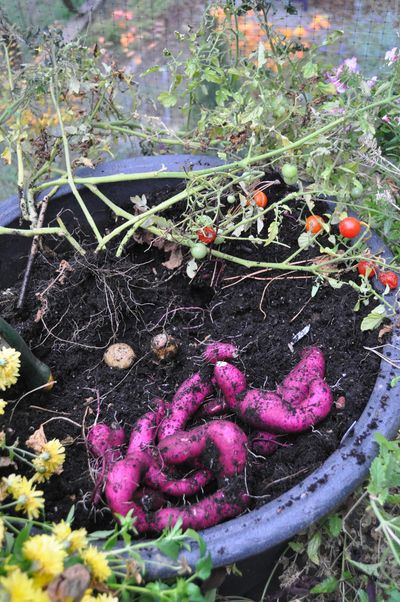Gardening with Pat Munts: Ketchup ‘n’ Fries not worth the price

I started a whole series of fun growing projects this summer. Some of them like the sweet potatoes and the grafted eggplant were smashing successes because of the hot summer. The Black Tail watermelon was a bust because the graft wasn’t strong enough to take on the first blast of heat in June.
My Ketchup ’n’ Fries plant was supposed to produce cherry tomatoes on the top and potatoes on the bottom. I left it in until now just to be sure it had the longest possible growing season to prove its mettle.
Was it worth the $20 plus shipping? No. The plant didn’t grow very well even in good potting soil, in a large pot with drip irrigation and a couple of fertilizations. We got a couple dozen small tomatoes that didn’t have much flavor off the top. Last weekend when I dug up the plants, we got exactly two 1 1/2-inch-wide potatoes. Not a very productive way to grow vegetables.
But that wasn’t the point. The challenge of growing a novelty plant was fun and made gardening a little more interesting. Most of the gardeners I know love playing around with plants and gardening techniques they have never tried. In the end it makes good storytelling for the winter. Next year there will be new candidates in the catalogs I can’t refuse.
For those of you who are wondering how this tomato-potato combination was even possible, the answer is straightforward. Tomatoes and potatoes are in the same plant family, Solanum. Because the genetics of the tomato and potato are very similar, they can be grafted together. Plant propagators grow small starts of both plants and then cut the top off the potato and the roots off the tomato and hold the two stems together with a special clip until they fuse together. The newly grafted plants are then placed in a growing chamber that keeps the humidity close to 100 percent and the temperatures in the 70s. After a week to 10 days the stems have begun to grow together and the plants are moved to a warm, humid greenhouse to finish healing. They then are grown out to the proper size for sale. All the extra hand work makes them more expensive than other vegetable starts.
I did get one bonus from the pot that had my experimental plants in it. To make it look pretty I also planted trailing black and chartreuse sweet potato vine in the pot. When I dug into the pot looking for Irish potatoes, I dug up a couple of pounds of purple-skinned sweet potato roots. These are a little different than the grocery store varieties but they are still edible, and we plan to eat them shortly with a good dose of brown sugar and butter.
Pat Munts is co-author, with Susan Mulvihill, of “Northwest Gardener’s Handbook.” She can be reached at pat@inlandnwgardening.com.